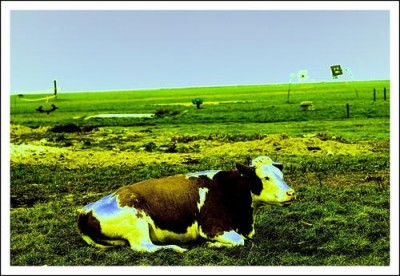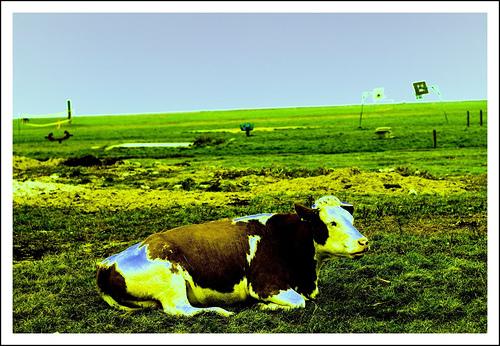The Department of Agriculture determined in April that a cow from California died from an always-fatal disease that triggers dementia and can be transmitted to people. The chilling news about the latest mad cow case was no surprise for me. I’ve been trying for two decades to stop the cattle feeding practices that transmit bovine spongiform encephalopathy, commonly called mad cow disease.
After the nation’s first proven case in 2003, Japan, South Korea, Taiwan, Malaysia, and Singapore all stopped buying U.S. beef. That prompted pledges from the U.S. government to ban the types of cattle feed linked to mad cow, and the trading resumed. The latest case has many countries re-examining U.S. safety standards, as well they should.

Mad Cow (Alex Kuhlmann/Flickr)
Indeed, once mad cow outbreaks move into human populations, all bets are off as to what could happen next.
The most recent case, a dairy cow in California’s Tulare County, developed an “atypical” form of the disease. The USDA says the case is unconnected to feeding practices, but that’s wishful thinking. No one knows how the case arose. Given our lax feeding standards, we can’t rule out that this animal consumed infected cattle products.
Despite four confirmed cases in less than a decade, U.S. cows, including dairy calves, are still taken from their mothers and fed the blood and fat of dead cattle. This risky feeding practice isn’t the only commonplace one. American cattle are still given feed containing cattle fat with traces of cattle protein.
In addition, U.S. chickens are fed cattle products. Then their “poultry litter,” which contains their feces and spilled feed, is fed back to cattle. That’s another route for mad cow infection.
These feeding methods have long been illegal in the UK and other countries that suffered through mad cow outbreaks and eventually took steps to stop them. Germany, France, and Japan all mandate thorough testing and enforce a strict ban on cannibal-feeding practices.
It’s high time the United States follow suit. Our government must stop relying on an inadequate testing system and outlaw the feeding of cow blood, fat, and protein to cattle.
Four years ago, the Kansas beef producer Creekstone Farms wanted to test its own cattle for mad cow disease, but was forbidden under penalty of law from doing so. Only the USDA can legally test for mad cow in America. In 2004 and 2005, after the second and third U.S. mad cow cases were discovered in Texas and Alabama, the government declared that mad cow wasn’t much of a problem and gutted its already anemic testing program. Today, only about 40,000 U.S. cattle a year are tested out of tens of millions slaughtered. It’s amazing that the California cow was even detected, given this miniscule testing program.
It’s relatively easy to fight mad cow disease. If your country has it, test each animal after it’s slaughtered to keep the diseased animals out of the food chain. Cheap, accurate, and easy tests in Europe and Japan identify the disease’s true extent and keep infected meat from being eaten.
We shouldn’t wait another day before implementing strict animal feeding rules and extensive animal testing, including testing by private companies. More than 170 people in the UK have died from the human variant of mad cow disease, including at least three people who were infected through infected blood transfusions.
Docile, eating whatever they are fed, trusting the rancher all the way to the slaughterhouse. Does that describe just the cows, or does it sum us up too?
